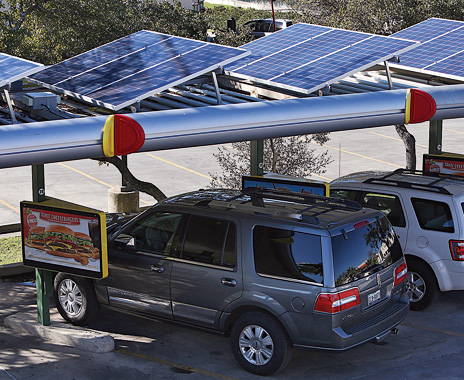When it comes to operating a profitable restaurant chain, energy costs have historically been lower on the priority list than food costs, wages, and real estate. Nevertheless, industry leaders say brands can reduce expenses long-term without dramatically changing the customer experience by investing in energy-efficient programs.
“If you are the person in the room that cares least about the environment, do it for your own bottom line. It is just responsible business in 2016,” says Michael Oshman, the founder and executive director of the national Green Restaurant Association, a nonprofit providing research and education to restaurants wishing to “go green.”
Corporate leadership at Sonic Drive-In began heeding this type of financial advice a few years ago, when several franchisees across the U.S. reported significant reductions in energy costs after installing solar panels on the roofs of their drive-ins.
To test the claims, the burger chain spent some $80,000 to have 90 solar panels installed on one of its corporate-owned restaurants in San Antonio in late 2015. The project earned a 50 percent solar rebate from local utility provider CPS Energy and a 30 percent federal tax credit.
In addition to the rebate and tax credit, Sonic has witnessed a $400–$500 decrease in the store’s monthly utility bill over several months. Wayne Brayton, vice president of facilities for Sonic, expects the investment to be paid for within a few years as it nets a 15–20 percent reduction in energy costs each month.
“It’s been remarkable,” Brayton says, noting that the signature Sonic canopy makes it an ideal place for solar panels. “I feel pretty positive that we will expand the test to other locations.”
Sonic locations have also begun using energy-saving LED lights instead of standard incandescent and fluorescent bulbs. About 95 percent of the 380 corporate stores and about a third of the more than 3,000 franchise-owned restaurants have converted to LED lights. The stores have reported $500–$1,000 in annual savings in energy costs, Brayton says.
Sonic’s experience with LED does not surprise Oshman, who says lighting counts for 10–15 percent of energy costs in restaurants—an amount that makes the easy switch to a more energy-efficient bulb even more enticing.
Oshman says an LED program is attractive because installation costs are typically low and bulb prices have decreased in recent years, with some sizes costing only a few dollars each.
In addition to reducing energy costs, Sonic stores have raked in tens of thousands of dollars in savings by taking advantage of a variety of rebates for energy-efficient initiatives offered at the local, state, and federal levels. Corporate stores alone have earned more than $100,000 in the last two years in rebates, discounts, and credits, Brayton says.
“There are several other things that we are looking at testing in the future, such as other energy-saving devices and some hardware and some software,” he says. “There are a lot of opportunities on the market. Energy savings is a huge issue for us and all of our competitors, as well.”
Sonic is not the only chain realizing the financial benefits of energy efficiency. In 2014, Dunkin’ Donuts created the DD Green Achievement, a rating system intended to build more energy- and water-efficient stores.
Of the more than 8,000 locations across the U.S., 73 stores have reached the DD Green Achievement standard, partly through the installation of LED lighting fixtures, energy-efficient mechanical units, and water-saving plumbing fixtures.
The standard also calls for stores to mitigate construction pollution, control waste recycling, improve indoor air quality, and use environmentally friendly, zero-VOC (volatile organic compound) paints. The chain hopes to have 100 stores reach the standard by the end of 2016.
“Franchisees who build DD Green Achievement restaurants see a great return on their investment. For instance, the improvements allow for lower utility costs, reductions in energy and water usage, as well as healthier indoor air quality,” writes John Herth, senior director of global design and construction at Dunkin’ Brands, in an email.
Beyond these standards, Oshman says, quick serves are also seeing returns from changing out aerators on sinks, installing motion sensors throughout restaurants, and updating spray valves with more efficient versions that, in some cases, use half the amount of hot water to clean pots and pans.
“We caution everybody, whether it is lighting or spray valves, to test them out. … You want to make sure that they work,” he says.
Sonic tests and collects data on energy-efficient fixtures and programs at corporate restaurants before making recommendations to franchisees, Brayton says. The financial benefits of energy-efficiency initiatives are also presented during the quarterly franchise advisory council meetings.
The initial investment for some fixtures—such as the thousands of dollars needed to install solar panels—can be a hurdle for some franchise owners, but most get on board when they learn of the significant financial benefits derived from such changes, Brayton says.
Oshman encourages quick-service chains to take a comprehensive approach. The first step, Oshman says, is to find a baseline by assessing current energy costs. Restaurants should quantify all elements of the operation that affect energy use, such as the number of standard and energy-efficient light bulbs and the average number of in-house diners.
All of these factors will determine how much money is saved, Oshman says.






